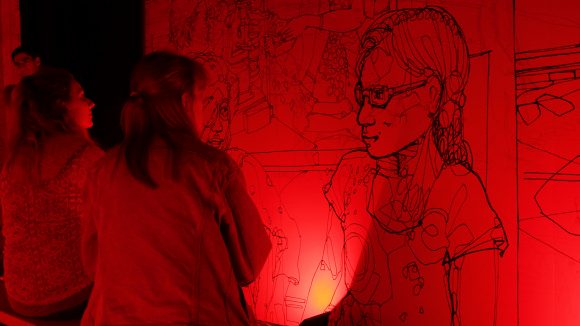Sightsavers’ inclusion work in 2018
The Social Inclusion Working Group’s final speaker session of the year focused on initiatives that colleagues from the group and beyond have been involved with throughout 2018.
For the group, this year has continued to build on the achievements of last year. The staff survey was the starting point, giving us an indication of how many of us working at Sightsavers have a disability as defined by the Equality Act, and how staff feel about disclosing their disability. The results of the survey were developed into an infographic, and will serve as baseline information that we can refer back to when we next conduct the survey.
Nearly all UK staff have now taken part in the disability awareness training module, which was developed by members of the group. We will now hold quarterly training sessions for new staff, while rolling out the training to our country offices. Feedback from staff taking part continues to be positive.
Meanwhile, Sightsavers CEO Caroline Harper spoke at the Global Equality & Diversity Conference to discuss our internal work around disability inclusion for the first time. This was a milestone for us and we hope to continue this external outreach to demonstrate the importance of focusing on disability inclusion in the workplace.
Related to human resources, HR Operations Manager Jamie Counihan explained what his department is doing to make our organisation more attractive to people with disabilities as a place to work. Sightsavers now advertises job vacancies on Vercida, a recruitment site that targets people with disabilities, and there are plans to expand this to other websites in the new year. Sightsavers is also forging links with local organisations including A Potential Diamond, which works with people with autism or learning disabilities in the south east.
We have changed our recruitment and interview process and are offering alternative ways to apply and be interviewed, including CV and video applications, Skype interviews and working interviews, where a candidate does a day’s work to try some of the tasks involved in the role they’re applying for. These approaches aim to increase the number of people with disabilities who work at Sightsavers.
Meanwhile, our online and design team have been very busy. Global Head of Online Neil Ayres explained the work that the team does to ensure all Sightsavers’ publications, web pages, printed materials, films and audio are accessible for people with disabilities. He introduced some of the tools used to check for accessibility, including an online simulator called Funkify: simulation software that enables the design team to view their work through the eyes of users with different abilities and disabilities. For example, it can simulate the pace and reading speed of someone with dyslexia by jumbling up letters on the page to make the content harder to read.
One area that the design team particularly focuses on is making sure digital versions of our documentation, including PDFs, are as accessible as possible: for example, so they can be read correctly by screenreading software. A lot of work has gone into this: Sightsavers designer Andrew Balchin has undergone extensive training and is now an expert in creating accessible PDFs. This ensures we can spread the word about Sightsavers clearly, so everyone can understand it.
Neil also offered a reminder about the importance of colour and labelling when creating graphs, particularly for people who are colour blind. “If you’re reliant on a single element – be it colour, text or a symbol – the opportunity for people to misunderstand is greater than if you use two or three different options.” For example, when designing a colour-coded pie chart, the different coloured segments may be difficult to distinguish for people with colour blindness unless text labels or symbols are also used.
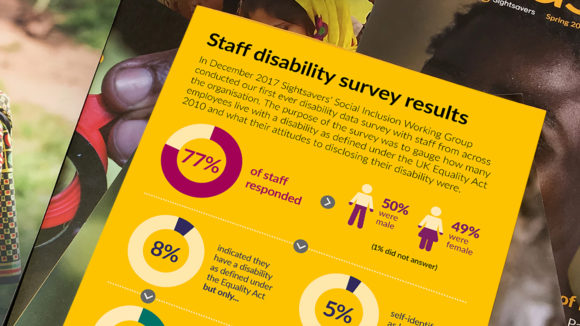
Sightsavers’ staff disability survey
In 2018 we collated the results of our survey into an infographic to present some of the key findings.
View infographic [pdf]Two members of Neil’s team, Louise Jones and Matt Roberts, went on to talk about Sightsavers’ installation at the D&AD design festival in April. The annual festival celebrates the world’s most creative design, advertising and marketing: Sightsavers’ stand aimed to raise disability awareness and encourage people to think about the world from the viewpoint of people with disabilities. Entitled ‘Perspectives’, it featured a host of interactive exhibits, including a box that enabled visitors to experience sound from the perspective of someone with autism. Visitors were also given the chance to write their name in braille using a special slate and stylus.
The main attraction was the colour room, which featured three panoramic, colour-changing illustrations, accompanied by emotive audio. As the lights changed, a different layer of the illustration was revealed to tell the story of Sightsavers’ work around the world. The team hopes to revive the installation to raise awareness of disability at future conferences and events.
Matt then discussed the article he wrote for Creative Review magazine about the challenges and assumptions he faces as a colour-blind designer, which you can read online here. The article generated a lot of interest, including from De La Rue, a company that designs international bank notes, which invited Matt to visit the company’s offices to talk to the design team.
So, with 2019 nearly upon us, we are committed to building on the achievements of this year and have already started planning. We hope all these initiatives will lead to a friendlier world for people with disabilities, especially in the areas of accessibility and employment, both at Sightsavers and beyond. Watch this space!
Author
![]() Kate Bennell is the organisational inclusion coordinator at Sightsavers UK. Severely sight impaired herself, she coordinates the Social Inclusion Working Group and champions accessibility.
Kate Bennell is the organisational inclusion coordinator at Sightsavers UK. Severely sight impaired herself, she coordinates the Social Inclusion Working Group and champions accessibility.
LinkedIn
Read about Sightsavers’ commitment to inclusion
Social Inclusion Working GroupMore from the
Social Inclusion Working Group
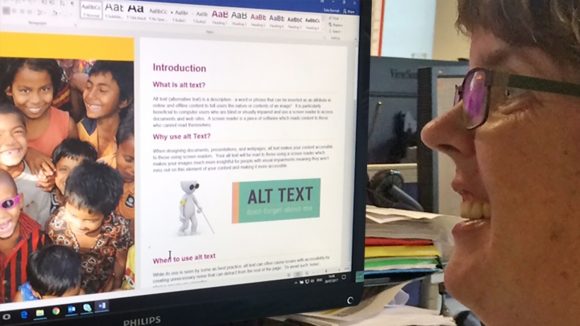
How to support people with hydrocephalus at work
Sightsavers’ Kate Bennell shares her experience of living with hydrocephalus and explains how employers can support colleagues with the condition.
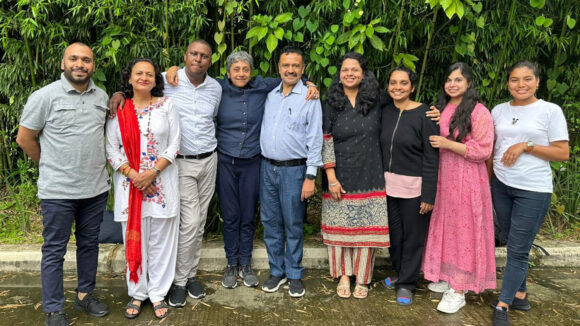
How people with psychosocial disabilities can claim their rights
Sightsavers’ Kate Bennell reflects on a recent talk led by Transforming Communities for Inclusion about psychosocial disabilities.
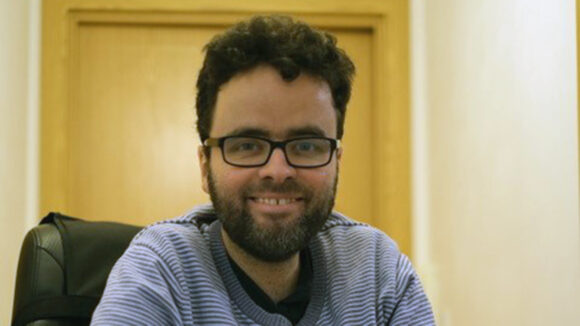
“My aim is to make the world a better place for disabled people”
Sightsavers’ Kate Bennell talks to Peter Fremlin, curator and author of the Disability Debrief, about the online newsletter which provides a disability lens on world news.
